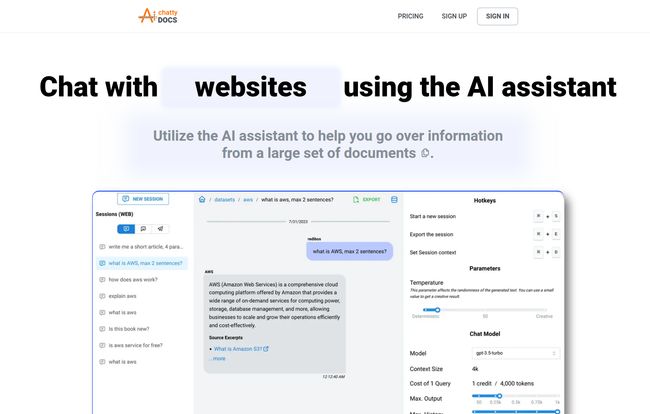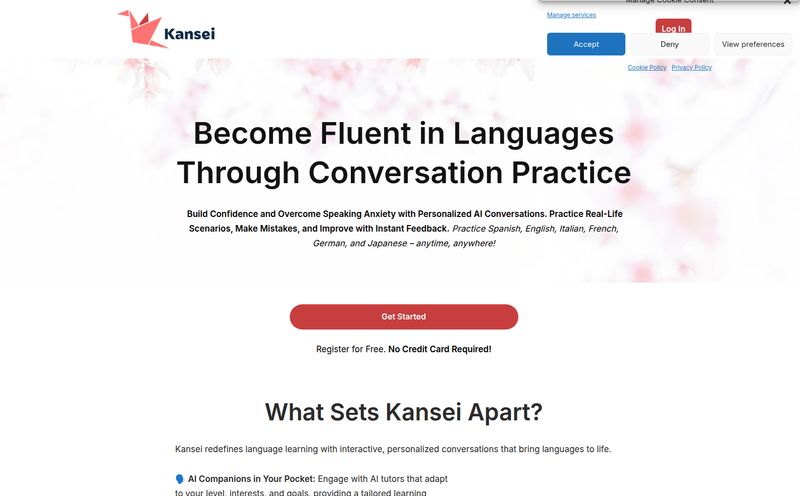If you're anything like me, your digital life is a chaotic mess of information. Right now, I have about 17 tabs open for a client's competitor analysis, a desktop folder overflowing with research PDFs for a new content strategy, and a bunch of random links I saved to Notion that I'll “definitely” read later.
It’s the classic information overload problem. We spend more time searching for the information we know we have than actually using it. For years, the dream has been to have a personal assistant who could just absorb all this stuff and give us the answers we need. Well, that dream is getting surprisingly close to reality. I've been playing around with a tool called ChattyDocs, and it’s one of the first AI assistants that genuinely feels... useful. Not just a novelty.
So, What is ChattyDocs Anyway?
Imagine you could hire a tiny, hyper-focused research assistant. You hand them a stack of documents, reports, and website links and say, “Memorize all of this.” Then, anytime you have a question, you can just ask them, and they'll instantly give you an answer based only on the materials you provided.
That's ChattyDocs in a nutshell. It’s an AI platform that lets you create a personalized chatbot based on your own documents. You feed it your PDFs, your text files, even links to websites, and it creates a private, secure knowledge base you can talk to. It's not trying to be a know-it-all like some other AIs; it’s an expert in one thing and one thing only: your stuff.
This is a fundamental shift from general-purpose AIs. Instead of getting a generic answer scraped from the wider internet, you're getting insights directly from your own curated content. For a professional, that is everything.
Getting Started is Surprisingly Simple
Honestly, I was expecting a complicated setup process. The world of AI can be intimidating, filled with talk of APIs, vector stores, and custom models. ChattyDocs thankfully sidesteps all that for the user. It boils down to a pretty simple three-step loop.
- Prepare Your Dataset: This is just a fancy way of saying “upload your files.” You can pull files directly from your computer or just paste in website links.
- Set the Properties: You get to define how your AI behaves. Give it a name, a personality, and control its creativity.
- Chat Away: Start asking questions via their web app or—and this is a great feature—directly through Telegram.
That’s it. There’s no code, no complex configuration. You're basically building a custom-trained AI without needing a computer science degree.

Visit ChattyDocs
Step 1: Feeding Your Personal Knowledge Base
The first step is creating what ChattyDocs calls a “dataset.” Think of a dataset as a project folder. For instance, I created one for “Q3 SEO Trends” and uploaded a bunch of industry reports and articles. You can upload various file types or just give it a URL to crawl. The AI works in the background to index all this information, so you’re not stuck waiting around. You can add or remove documents at any time, which keeps your knowledge base fresh.
Step 2: Giving Your AI a Personality
This is the fun part. You can actually instruct the AI on how it should behave. You can tell it to be a formal research assistant, a sarcastic partner, or a straightforward teacher. You also have a slider for “creativity.” Do you want purely factual, deterministic answers, or do you want the AI to make some logical leaps? I personally keep it on the lower end of creativity for factual research but dial it up for brainstorming sessions. It’s a subtle but powerful touch.
Step 3: The Conversation Begins
Once your dataset is ready, you just open a chat window and start asking questions. “What were the top 3 traffic sources mentioned in the 'Semrush Report'?” or “Summarize the key findings from that Moz article.” The responses are fast, and here's the best part... they come with sources.
The Features That Genuinely Impress Me
I see a lot of AI tools, and many are just thin wrappers around the same core technology. ChattyDocs has a few features that show they actually understand the workflow of their users.
Source Citations are a Non-Negotiable
This is the big one. If an AI gives me a piece of information, I need to know where it came from. ChattyDocs provides the source for its answers, linking back to the specific document or even the page number where the information was found. It's a game-changer for building trust in you're AI's outputs and is absolutely essential for anyone doing serious research or writing. No more blindly trusting a black box.
Telegram Integration is a Killer Feature
I didn't think I'd care much about this, but I was wrong. Being able to chat with my project data through Telegram on my phone is amazing. I was out for a walk the other day and had a sudden idea for an article. I just pulled out my phone, asked my “Blog Ideas” dataset a few questions, and got the facts I needed without having to run back to my laptop. It's convenience personified.
Sharing Your Custom AI Experts
You can also share your datasets with other users. I can see this being incredibly useful for small business teams, study groups, or agencies that want to create a centralized knowledge hub for a specific client. Everyone gets access to the same single source of truth.
Let's Talk Money: The ChattyDocs Pricing Plans
Alright, the all-important question: what does it cost? The pricing is subscription-based, with a few tiers that cater to different needs. They do offer a free trial, which is great for getting your feet wet without commitment.
| Plan | Price | Best For |
|---|---|---|
| Casual | $9 / month | Students, solo bloggers, or anyone with personal projects. The limits are generous enough for individual use. |
| Scale | $49 / month | Freelancers, small agencies, and professionals who need more firepower, unlimited documents, and API access. |
| Enterprise | $399 / month | Larger teams and businesses that need extensive usage, more bots, and priority support. |
For the most current details, you should always check their official pricing page.
My take? The Casual plan is a steal. For the price of a couple of fancy coffees, you get a powerful research assistant. The Scale plan makes sense once your projects start getting more complex or if you want to integrate the tech into your own workflow via the API.
The Good, The Bad, and The AI
No tool is perfect. While I'm pretty high on ChattyDocs, it’s important to be balanced. It's incredibly easy to use and the ability to use your own documents as a knowledge base is fantastic. The source citation and Telegram integration are standout features.
On the flip side, you are limited by your subscription's quota, so heavy users will need to monitor their usage. The tool is only as good as the documents you provide it; you have to put in the work to build the knowledge base. And for some, the pricing might be a barrier, though I think the value is there, espcially on the lower tiers.
My Final Verdict: Who Should Use ChattyDocs?
So, who is this for? In my opinion, ChattyDocs shines for a few key groups:
- Students and Researchers: Imagine uploading all your lecture notes, textbooks, and research papers and being able to quiz yourself or find specific facts instantly. It’s like having the ultimate study buddy.
- Content Creators and Marketers: I fall into this camp. I use it to synthesize research, pull stats from reports, and brainstorm ideas based on my own curated content libraries.
- Business Professionals: Anyone who deals with a lot of documentation—think legal contracts, financial reports, or technical manuals—can use this to quickly find the needle in the haystack.
If you're looking for a general-purpose AI to write a poem or a social media post, this ain't it. But if you're looking for a specialized tool to help you make sense of your own mountain of information, ChattyDocs is one of the best I've seen. It’s focused, practical and it just plain works.
Frequently Asked Questions about ChattyDocs
- 1. Can I try ChattyDocs for free?
- Yes, absolutely. They offer a free trial that includes 20 queries and a decent amount of text upload capacity, so you can test it out with your own documents before committing. No credit card is required to start.
- 2. How is ChattyDocs different from something like ChatGPT?
- The main difference is the source of information. ChatGPT pulls from a massive, general dataset from across the internet. ChattyDocs only uses the specific documents and links you provide, making its answers highly relevant and verifiable within your own context.
- 3. What kind of files can I upload?
- You can upload common document types like PDFs and text files. You can also provide links to websites, and the AI will crawl and index the content from those pages for your dataset.
- 4. Is my data kept private and secure?
- Privacy is a huge concern with AI. ChattyDocs is designed to keep your datasets private to you unless you explicitly choose to share them. Your uploaded documents create a sandboxed knowledge base for your AI only. As with any cloud service, it's always wise to review their latest privacy policy for specifics.
- 5. What exactly is a "dataset" in ChattyDocs?
- Think of a dataset as a container or a project. You would create one dataset for your 'History Class Notes', another for 'Client X Project Files', and maybe a third for 'New Recipes'. Each dataset is a separate knowledge base that your AI can talk to.
- 6. Can the AI access the internet to answer my questions?
- No, and that's a feature, not a bug! The AI is restricted to only the information you've uploaded to a specific dataset. This prevents it from pulling in random, unverified information from the web and ensures all answers are grounded in your source material.



